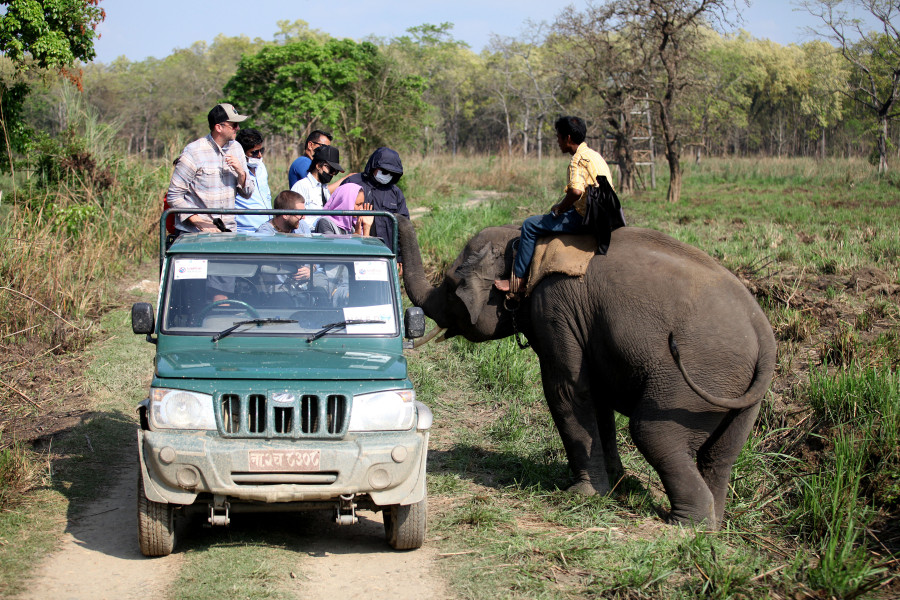Columns
Let sleeping animals lie
Operating nighttime safaris in Chitwan National Park in a bid to increase tourist numbers is an absurd idea.
Anuj Ghimire
The future of wildlife and organismal biodiversity is hanging by a thread. Habitat encroachment, pollution, overexploitation of natural resources and, of course, rising global temperatures are some of the factors contributing to the decline in animal populations. While we should be working on protecting the integrity of the natural ecosystem, the government, on the contrary, comes up with ideas to disrupt these fragile ecosystems. A recent example being the absurd idea of operating nighttime safaris in Chitwan National Park in a bid to increase tourist numbers during Visit Nepal 2020.
Regardless of the time of the day or night, driving a motor vehicle through the jungle is a form of disturbance. Animals and plants rely on various environmental cues called zeitgebers to sync their circadian rhythms. One of the most important zeitgebers is photoperiod, the period when there is light. The changing photoperiod during different seasons helps the animal to prepare for the coming season. Light pollution during the night has been found to have one of the most detrimental effects on wildlife, affecting not only their behaviour but also their physiology—especially their reproductive physiology.
Animals have been responding to the changing photoperiod that tells them when to come out of hibernation, start migrating or start laying eggs. All the biological systems in our ecosystem are synced to these cues. For example, if birds were to start laying eggs a month earlier due to their biological system being reset by artificial light, the insects that form the food for chicks could still be hibernating. This means the chicks are going to be unfed, and will end up not surviving their growth phase when they need to eat a lot.
Stressful conditions during growth or normal conditions impact animals in numerous ways. Human-induced disturbances or changes have been found to affect sexual selection in different animals. Most animals, especially birds, rely on their appearances to find or attract a mate. But these disturbances, whether it’s habitat destruction or physiological alteration due to noise and pollution, affect their morphology to some extent.
Whether it’s low quality food or stress during growth that’s affecting their plumage or their song, which play an important role in sexual selection in birds, many species are being either directly or indirectly affected by these changes. If you depend on your song and plumage to attract a male, and if you end up getting low quality morphological or physiological traits, there’s a big chance that you won’t be selected. Multiple studies have shown that song quality or vocalisation in birds are affected due to human-induced noises. Noise or light pollution or anything that’s human-induced affects species on a physiological level.
Artificial light has been known to affect plants too. Disturbances affect animals, whether it is light pollution or sound pollution. Just being in their territory and disturbing them can stress them out on a superficial level, but activities like night safaris only aggravate the problem they are already facing. It doesn’t even have to be on a physiological level.
There are multiple organisms in Chitwan National Park who are on the verge of endangerment. Conservation is not just for flagship species. It’s for all species. But in Nepal, most of the talk in conservation revolves around tigers and rhinos. The country has a sizable common leopard population as well, but we never get data about the population status or the conservational aspect of this species. Leopards primarily prey on small mammals. Why physically disturb and disperse the prey of these predators by driving a jeep into the jungle in the night when they are actually hunting or are active? How can that be conservation? You can’t double the population of one species and disregard other species totally and call it conservation. Plus, the safety of the tourists being amid wild animals should be an issue too. Conducting night safaris to aid the conservation of the species sounds absolutely absurd.
If the idea behind the nighttime safari is truly being done for conservation proposes, then it would be better to support students in their research to understand the state of our animals and measure their stress levels. This will be a greater help for conservation than disturbing them more than they already are. The first step in conservation is to 'know the animal'. If you don’t know the biology or ecology of the animal, you won’t be able to conserve the species. It might seem like something not important or something that might not affect animals; but in the long term, things like these will definitely be detrimental to the species. If we are not careful in the activities we choose to promote for Visit Nepal 2020, we may only have pictures of wildlife to show the tourists during the next Visit Nepal campaign. Conservation simply does not come from disturbing animals in their habitat.
***
What do you think?
Dear reader, we’d like to hear from you. We regularly publish letters to the editor on contemporary issues or direct responses to something the Post has recently published. Please send your letters to [email protected] with "Letter to the Editor" in the subject line. Please include your name, location, and a contact address so one of our editors can reach out to you.




 17.12°C Kathmandu
17.12°C Kathmandu















